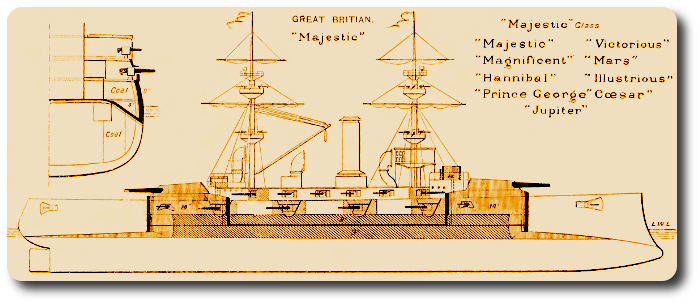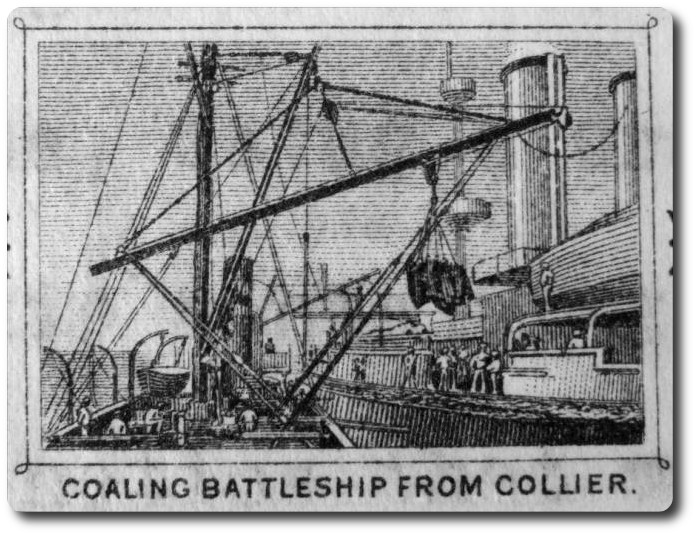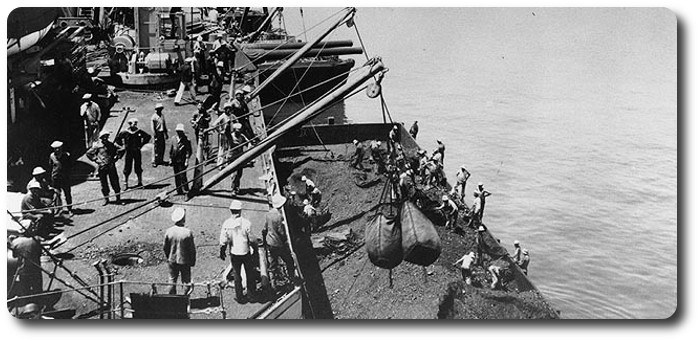Topic: Drill and Training

Coaling Ship; a matter of pride
1899 – Coaling Battleships; A Matter in Which the British Navy Leads the Whole World
St John Daily Sun, 5 August 1899
H.M.S. Jupiter, Lough Swilly, July 24.—Today that portion of the fleet which arrived here on Saturday, viz., eight battleships and nine cruisers, has been bust coaling. Coaling ship has risen to the dignity of an evolution, and is considered as of much importance as sail drill was in the old days. A record in coaling now arouses as much pride as a record in crossing royal yards did in the time of the sailing ship. And it is not to be wondered at, for not only are coal and steam to the sailors of today what wind and sails were to their forefathers, but the exercise is one of the highest tests of thorough efficiency in a ship. Smart coaling shows a well-drilled ship's company, good comradeship in all ranks, intelligence and readiness of resource, in the officers smartness and alertness, and arouses the strongest esprit de corps.
Speed in coaling has, like almost everything else, and element of luck in it. The collier may be a bad one to work from, as, for instance, the one we have been coaling from today, which has one winch our of gear and the other two rob one another of steam. Of course the Temperley transporter is employed in this fleet, but besides it both ships' and colliers' winches are brought into play. The Temperly is so well known that it is scarcely necessary to describe it, but for the benefit of those unacquainted with this most ingenious device I may state its action. It is hung from the ship's derrick, one end being over the hold of the collier, and the other over the ship's hold. The whip runs the coal to the end of the Temperley, where the clutch is released, slides along the transporter and carries the bags to the other end to the point where they are to be lowered.
The record for coaling is held in this fleet of battleships by the Majestic, which took in no less than 197 tons in one hour, and averaged over 180 tons per hour. She had, of course, a splendid collier, and, moreover, and not to break bulk or sweep. A collier serves, say, three ships. The first will have to break bilk with the collier's cargo, and will perform the work somewhat slowly at first. The second ship will have the pull of both the others, for she will not have to break bulk or sweep. The third ship will have to do the sweeping, for she will have to take out all the coal that is in the collier, and will have to sweep the holds and collect all the coal at the end so as to entirely clean the ship out. And this is the case today with the Jupiter.
An impression prevails ashore that ships' crews get extra pay when involved in coaling. This is not the case. A few ratings, such as lampmen and machine servants, do get one shilling a day is employed coaling, but no others, though there is an allowance of 4s. 6d. per half year to bluejackets and marines to cover damage to clothing. And most decidedly 9s. per annum is a very small allowance for this purpose.
I believe that about 100 tons per hour, or something more, will be the average rate of coaling for the battleships. Apropos of this, the following figures as regards to coaling of the international squadron at Crete during the recent trouble in that island are worth giving. The French took in thirty to forty tons per hour; the Italians twenty tons; the Germans, Austrians and Russians averaged about ten; while to the amazement of our foreign comrades, the British took in their coal at a little over 100 tons per hour—one more proof of the tremendous superiority of the British navy over that of other navies.


Apparently, the dreadnought building naval arms race of the early 1900s was not competitive enough. The British and US Navies maintained an international spirit of competition with the pace at which crews transferred coal from lighters into their warships' coal bunkers:
1901 – Records for Coaling Ship — Massachusetts Leads the World with 248 Tons per Hour; Alabama, 222; Kearsarge, 219; and British Ariadne, 203 — Newport, R.I., Aug. 1—The battleship Massachusetts, so the statement is made here by a naval officer, holds the world's record for coaling ship. The British ship Adriane of the English channel squadron held the record till last spring, when the North Atlantic fleet coaled up at Pensacola. The Adriane's record was 203 tons an hour, but the Massachusetts at Pensacola, with flat lighters in use, put in 248 tons. The Kearsarge and the Alabama also beat the Adriane's record at the spring coaling in the South, the former putting in 218 tons an hour and the Alabama 22 tons. It is said these records have never been made public before. (Boston Evening Transcript, 1 Aug 1901)
1906 – HMS Euryalus, returning from the manoeuvres, made an interesting record in coaling. Twelve hundred and four tons were got into the bunkers in eight and a half hours, as average of 141.6 tons an hour, the best hour giving 165 tons. Seeing that the Euryalus is a training ship, and that the work was done by boys, this is a splendid record. ("Blasts from the Trumpet," The Quebec Saturday Budget, 11 Aug 1906)
1906 – The battleship Victorious, while coaling at Gibraltar, took on board 900 tons at an average speed of 305.4 tons an hour. This establishes a new record in the British Navy. ("Blasts from the Trumpet," Quebec Saturday Budget, 20 Oct 1906)
1906 – The world's record for coaling has been broken by the new cruiser Duke of Edinburgh, which belongs to the Second Cruiser Squadron under the command of Rear-Admiral Prince Louis of Battenburg. She took on 1,420 tons of coal from the lighters at Gibraltar recently at an average rate of 316 tons an hour. ("Blasts from the Trumpet," The Quebec Saturday Budget, 24 Nov 1906)
1907 – Broke Coaling Record — Newport, R.I., Dec. 4—The battleship Vermont of the Atlantic Squadron, which is soon to sail for the Pacific ocean, has won the Navy's record for coaling ships from four barges at the navy coaling station in Narraganset Bay, She averaged 255 tons per hour, against the battleship Virginia's record of 253 tons per hour. (Spokane Daily Chronicle, 4 Dec 1907)

Sadly, in an era when safety standards were certainly not what they would be in a modern military or industrial environment, accidents happened:
1906 – While the officers and men of H.M.S. Queen were trying to create a record in coaling at Cephalonia a bag of coal fell on the head of Lieutenant Gotto, and he died almost instantly. ("Blasts from the Trumpet," Quebec Saturday Budget, 20 Oct 1906)

